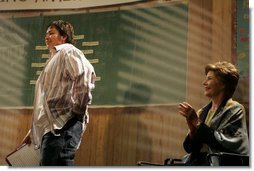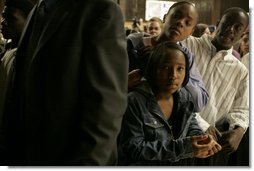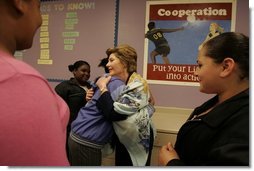|
Home >
News & Policies >
April 2005
|
For Immediate Release
Office of the First Lady
April 28, 2005
Mrs. Bush's Remarks on Helping America's Youth in Alameda, California
Chipman Middle School
Alameda, California
10:17 A.M. PDT
MRS. BUSH: Thank you all. Jorge, thank you very much. Thank you for that introduction. Thank you for telling us your story and how you like to read now. I think that's so terrific.
I especially want to recognize the Principal, Ms. Laurie McLachlan. Thank you very much. Thank you for your leadership. (Applause.) In a roundtable I was in earlier with teachers from the school and some students, one of the things I learned is how important Ms. McLachlan is to her school, how important it is to have as your principal somebody who really understands instruction, but also who builds everybody, and thank you very much for doing that. (Applause.)
 Also the Superintendent, Dr. Allen Nishino is here. Thank you very
much, Superintendent, for joining us. I don't see him right here, I
think he's -- here he is, right over here. Thank you very, very much.
(Applause.)
Also the Superintendent, Dr. Allen Nishino is here. Thank you very
much, Superintendent, for joining us. I don't see him right here, I
think he's -- here he is, right over here. Thank you very, very much.
(Applause.)
And I especially want to thank all of the teachers who are here. All of us are grateful for all that you do to help our sons and daughters succeed. Thank you for choosing teaching and thank you for devoting your lives to children. Thank you very much for that. (Applause.)
And of course, the real reason I'm here is because of all the students. Thank you all. Thank you for your hard work. I want to wish you the very best. (Applause.)
Teaching and education are critical components of a new initiative called Helping America's Youth. The goal of Helping America's Youth is to help children make good decisions in their lives so that they can grow up to be healthy, successful adults. The initiative calls for action in the three most important parts of a child's life: a child's family, a child's school and a child's community. We're emphasizing the needs of boys because statistics show us that boys are more likely to fall behind girls in school, they're more likely --
STUDENTS: Awww.
MRS. BUSH: The girls might not be unhappy about that. (Laughter.) They're more likely to drop out of school, and today in America, fewer boys than girls go to college or go on to graduate school.
We all know that boys and girls, as they reach their teen years, face hazards. Smoking and drinking may look appealing to children when they see older kids doing it. Drugs are a temptation. Young people often feel pressured to have sex. Gangs and violence are a regular presence in many neighborhoods.
These challenges aren't limited to any one part of the country or to any one segment of society. Every child has to make choices between healthy behaviors that lead to success and risky behaviors that can lead down a road to bad outcomes. Our responsibility as adults is to help children resist negative pressures and then to help them excel in every part of their lives.
Schools are central to a child's life. For at least six hours a day, boys and girls come here to learn the knowledge and the skills that they'll need to become intelligent and discerning adults. We also want them to learn to respect themselves and to respect others. We want them to learn that they're responsible for the choices they make in life. Students who do well academically and socially are more likely to stay interested in their schoolwork, to avoid negative behaviors and to graduate from high school and go on to college.
 Researchers in Baltimore found out that children have to be taught
how to be good students; it's not just intuitive. And really, I think
that's what you're doing with your life skills. You're teaching
children how to be good students and what they need, what
characteristics they need to be good students.
Researchers in Baltimore found out that children have to be taught
how to be good students; it's not just intuitive. And really, I think
that's what you're doing with your life skills. You're teaching
children how to be good students and what they need, what
characteristics they need to be good students.
In [Baltimore], they devised a program called the Good Behavior Game that helps first graders learn how to behave in the classroom. Studies show that the first graders in Baltimore public schools who participated in the Good Behavior Game are better behaved and less disruptive in class all the way through high school. In fact, 86 percent of the children who participated in the Good Behavior Game graduated from high school, compared to just 19 percent of their peers.
In Atlanta, middle school students are learning how to debate. The Computer Assisted Debate project -- or CAD -- is helping children from the city's housing projects improve their vocabulary and their language skills, which makes it more likely they'll complete high school and go on to college. CAD also helps students find their voice. Rather than turn to violence and anger as a means of expression, debate is a healthier option, safer for children and for their community.
Here at Chipman, you're preparing students for a lifetime of success by helping them develop a strong character, and at the same time, by helping them improve their reading and language and math abilities. In every class, students learn life skills and lifelong guidelines that reinforce the importance of being responsible, caring and trustworthy. These lessons lay the foundation for a safer school environment in which students treat each other and their teachers with respect.
All of Chipman's students spend several periods a day in classes that incorporate language arts, because reading is the essential skill for a child. Boys and girls who get to high school without sound reading skills are at a greater risk of bad behavior, depression, substance abuse and violence. And of course, they're the ones who drop out of school.
Teenagers who have reading problems have told researchers at the National Institute of Health that they hate to read, primarily because it's such hard work, and their reading is so slow and laborious. One teenager said, "I would rather have a root canal than read." (Laughter.)
 Education research now gives us a better understanding of how
people at different ages respond to different methods of teaching.
What works for a student in the third grade won't necessarily work for
a student in the sixth grade or the eighth grade. And when students
are learning English as a second language, like Jorge, they have even
greater challenges. Students at Chipman speak 26 different languages.
Teachers have the skills and the reading programs to help all students
improve their reading ability and to motivate children to communicate
well in English.
Education research now gives us a better understanding of how
people at different ages respond to different methods of teaching.
What works for a student in the third grade won't necessarily work for
a student in the sixth grade or the eighth grade. And when students
are learning English as a second language, like Jorge, they have even
greater challenges. Students at Chipman speak 26 different languages.
Teachers have the skills and the reading programs to help all students
improve their reading ability and to motivate children to communicate
well in English.
This morning, I met Dominique. Dominique is in the eighth grade, and when he came to Chipman, he had trouble reading. He was placed in the program called REACH. Dominique worked very hard and made great progress. At the end of last year he walked through the office at Chipman demonstrating all the big words he could read. Seeing a child who is beaming with pride at his academic success warms the heart of every teacher and every parent. Dominique is a great example of the excitement and the confidence that children gain when they improve their reading skills. Dominique, would you please stand and be recognized? (Applause.)
I know that Dominique and Jorge are not the only students at Chipman with great success stories. Congratulations to every one of you who's working hard to become a better reader.
The Striving Readers program, which is part of Helping America's Youth, helps school districts implement research-based reading programs like REACH. As more schools use programs that are proven to work, more students will have the chance to improve their reading skills. They'll be more likely to stay in school and gain the education and the confidence they need to become successful adults. Last year, Striving Readers was introduced with $25 million in federal funding. For 2006, President Bush has requested $200 million to help more students improve their reading skills.
The President has also requested more than $24 million for a Character Education Initiative to encourage schools to teach strong values, promote good character and help children develop a sense of responsibility to their families and to their communities. And he's proposed a new three-year $150 million initiative to help children avoid gang involvement and gang violence.
One of the most important ways the federal government can help local communities is by fostering good connections between people who are running good programs and people who want to get started. This fall, we'll convene a White House Summit on Helping America's Youth to discuss some of the best practices to help children avoid risky behaviors and become responsible, healthy adults. The conference will introduce a new assessment tool so that communities can identify the challenges that they face and the services they already have to meet those challenges. Then community leaders can integrate federal and local programs to create seamless efforts for the children in their communities.
 Helping America's Youth depends on partnership within communities,
and on the individual commitment of every American. The time between
childhood and adulthood is all too short -- as George and I can attest
-- and every moment in a child's life is precious. After I visited a
program in Detroit, a newspaper reporter asked one of the little boys I
met what he thought of my visit, and I was moved when he said, "I wish
she could stay here." Children want us in their lives and children
need us in their lives. And as I've learned from the remarkable men and
women I've met here today, each of us has the power to make the
difference in the life of a child.
Helping America's Youth depends on partnership within communities,
and on the individual commitment of every American. The time between
childhood and adulthood is all too short -- as George and I can attest
-- and every moment in a child's life is precious. After I visited a
program in Detroit, a newspaper reporter asked one of the little boys I
met what he thought of my visit, and I was moved when he said, "I wish
she could stay here." Children want us in their lives and children
need us in their lives. And as I've learned from the remarkable men and
women I've met here today, each of us has the power to make the
difference in the life of a child.
Thank you all very, very much. Congratulations to all the students who are working hard and thanks to your great teachers. Thank you very much. (Applause.)
END 10:29 A.M. PDT


